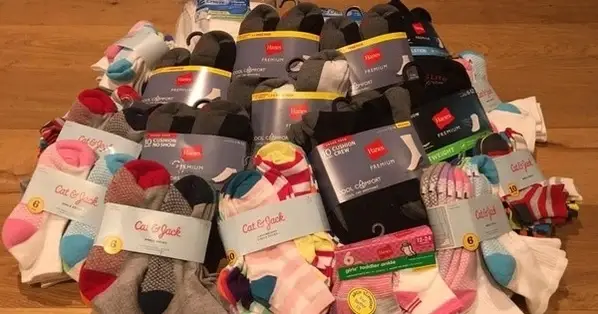How to Host a Sock Drive

Ingredients
- Clean, new socks
- Cardboard or plastic boxes
- Socktober’s sign templates
- Plastic bags
- Reusable cloth bags
- Shelter or organization that accepts sock donations
Recipe
1. Contact shelters and organizations that support people experiencing homelessness.
- Ask whether they accept sock donations or have specific donation requirements, such as that socks must be new and unopened.
- Organizations like Socktober and Sock It To Em provide resources for hosting a sock drive, such as sign templates.
2. Choose sock collection locations.
- Decide whether you want neighbors to drop sock donations off at your house, or if you’d prefer to partner with local community centers, schools, and libraries that will allow you to leave collection boxes.
- Be clear about how long the drive will last and how often you’ll retrieve donations.
3. Clearly label donation boxes with information about the drive.
- Place cardboard or plastic boxes at each location, along with information about the sock drive, where socks will be donated, and donation requirements.
4. Use promotional materials to spread the word.
- Create flyers, social media posts, or emails to advertise the sock drive in your community.
- Promotional materials should highlight how the drive is supporting people experiencing homelessness, along with details about donation requirements and where to find collection boxes.
5. Regularly collect donations.
- Check on collection boxes weekly to collect donations.
- Sort and organize socks based on size and condition.
6. Donate socks to local shelters or organizations.
- Neatly pack donations in cardboard boxes, plastic bags, or reusable cloth bags before dropping off at a shelter or nonprofit organization.
Nutritional Information
How this recipe has nurtured a community
“We used signs, word of mouth, Facebook events, and Instagram stories [to promote the sock drive]. We had extensive support from [Idealist] HQ, as well as the New York City, Queens, and Northern New Jersey Idealist Groups. They helped collect socks, promote the event, and we are all cheerleaders for each other! I love that there are idealists all over the world making a difference in their communities.”
— Dori C., New York
Finishing Touch
Did you know that 40% of people experiencing homelessness live unsheltered, which can mean they don’t have regular access to necessary resources. If you often encounter people who are unsheltered and asking for help, consider organizing and handing out care kits.
Care kits can include water bottles, granola bars, feminine hygiene products, cash, gift certificates to fast food restaurants, band-aids, chapstick, hand warmers, gloves, and other useful items. Pack these resources in plastic or reusable cloth bags to keep in your car the next time someone asks for assistance.

